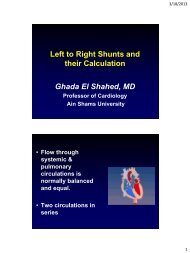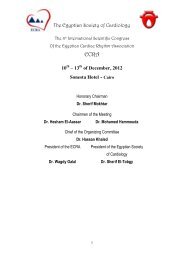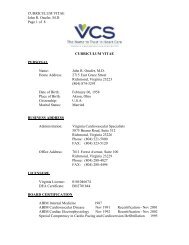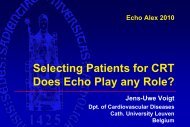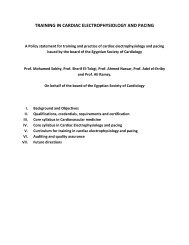the egyptian society of cardiology board of ... - Cardioegypt.com
the egyptian society of cardiology board of ... - Cardioegypt.com
the egyptian society of cardiology board of ... - Cardioegypt.com
Create successful ePaper yourself
Turn your PDF publications into a flip-book with our unique Google optimized e-Paper software.
Rania El Hoseiny, et al<br />
Review <strong>of</strong> literature revealed studies conducted<br />
only on evaluation <strong>of</strong> cardiac dysfunction due to<br />
traumatic brain injury.<br />
Bahloul, et al, in 2006, studied cardiac dysfunction<br />
due to traumatic brain injury in 202 patients,<br />
only two patients (representing about 1%) reported<br />
to have global hypokinesia with a decrease in<br />
LVEF to 0.40 that <strong>com</strong>pletely recovered during<br />
follow-up 7 days after <strong>the</strong> initial study [28].<br />
Wittebole, et al, in 2005, described-in <strong>the</strong> previously<br />
mentioned case report-hypokinesia <strong>of</strong> <strong>the</strong><br />
inferior wall <strong>of</strong> <strong>the</strong> left ventricle that normalized<br />
on day 6 after <strong>the</strong> trauma [19].<br />
7- Regarding <strong>the</strong> correlation between neurological<br />
status and ECG analysis:<br />
In <strong>the</strong> present study we found a statistically<br />
significant higher frequency <strong>of</strong> abnormal ECG in<br />
day 1 in those patients with severe aneurysmal<br />
SAH (100%) when <strong>com</strong>pared to those with mild<br />
aneurysmal SAH (58.3%) [p value=0.035], <strong>the</strong>n<br />
<strong>the</strong>re was a tendency toward higher frequency <strong>of</strong><br />
abnormal ECG in day 7 in those patients with<br />
severe SAH as <strong>com</strong>pared to those with mild SAH,<br />
yet this tendency lacked any statistical significance<br />
(75% versus 41.7%, p value=0.142).<br />
Similarly, Zar<strong>of</strong>f, et al, in 1999, who studied<br />
ECG abnormalities in aneurysmal SAH and <strong>the</strong>ir<br />
correlation with neurological status (assessed with<br />
Hess & Hunt score), <strong>the</strong>ir study was conducted on<br />
58 patients and <strong>the</strong>y concluded that ECG abnormalities<br />
are associated with more severe neurological<br />
injury [9].<br />
Contrary to our results <strong>the</strong> data published by<br />
Penka, et al, in 2005, who studied <strong>the</strong> correlation<br />
between ECG abnormalities in aneurysmal SAH<br />
patients and <strong>the</strong> degree <strong>of</strong> neurological impairment<br />
(assessed with Hess & Hunt score),<strong>the</strong>y concluded<br />
higher frequency <strong>of</strong> ECG changes (88.89%) in<br />
patients with lower grades <strong>of</strong> neurological impairement<br />
(patients with Hess & Hunt score 1&2)<br />
(p



